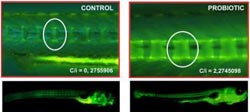New study shows probiotics help fish grow up faster and healthier

<br>
This research could help increase the success of raising rare ornamental fish to adulthood. It also has implications for aquaculture, since accelerating the development of fish larvae–the toughest time for survival–could mean a more efficient and safe system for bringing fish to the dinner table.
Tiny zebrafish are often used in genetic research because scientists can easily track changes in their development and the fish grow quickly. They also share many of the same genes as humans and can be used for studying cellular and physiological processes and their impact on human disease.
“This is really exciting,” said Jacques Ravel, a leading genomic scientist studying the role of the human microbiome in health and disease at the University of Maryland School of Medicine Institute for Genome Sciences. “Knowing you can colonize the gut of a zebrafish with a probiotic strain and improve its development becomes an interesting model for us to study the beneficial effect of probiotics in children and adults.” He and his colleagues are currently looking into the effect of Lactobacillus rhamnosus probiotics on the gut development of premature infants.
In the zebrafish experiment, researchers added Lactobacillus rhamnosus, a probiotic strain sometimes used in yogurt, to the zebrafish water. The fish drank the probiotic through their gills, and it landed in their gastrointestinal tract, preventing bad bacteria from taking over and promoting growth, including advancing the development of bone, vertebrae, and gonads.
“If you have increased growth and survival from each batch of hundreds of thousands of eggs, that is a huge benefit,” said study co-author Dr. Allen Place of the Institute of Marine and Environmental Technology.
Probiotics helped the zebrafish get through the touch-and-go time when their gastrointestinal tract is maturing. They are still living off yolk with which they are born, and it is during this weaning period when most mortality occurs. Adding probiotics to the water increases the survival rate of zebra fish larvae from 70% to 90%.
“We did not anticipate the enhancement in maturation,” said Place. “When you look at various molecular markers of stress, the overall stress in the fish that were treated with the probiotic were lower–which may be the reason for the development.”
The study, Lactobacillus rhamnosus Accelerates Zebrafish Backbone Calcification and Gonadal Differentiation through Effects on the GnRH and IGF Systems, was published in the September issue of PLOS ONE. Researchers include Matteo Avella and Oliana Carnevali from the Polytechnic University of Marche in Italy; Allen Place, Shao-Jun Du, Yonathan Zohar and Ernest Williams of the Institute of Marine and Environmental Technology in Baltimore, Maryland; Stefania Silvi of the University of Camerino in Italy.
UNIVERSITY OF MARYLAND CENTER FOR ENVIRONMENTAL SCIENCE
The University of Maryland Center for Environmental Science unleashes the power of science to transform the way society understands and manages the environment. By conducting cutting-edge research into today's most pressing environmental problems, we are developing new ideas to help guide our state, nation, and world toward a more environmentally sustainable future through five research centers—the Appalachian Laboratory in Frostburg, the Chesapeake Biological Laboratory in Solomons, the Horn Point Laboratory in Cambridge, the Institute of Marine and Environmental Technology in Baltimore, and the Maryland Sea Grant College in College Park.
Media Contact
More Information:
http://www.umces.eduAll latest news from the category: Life Sciences and Chemistry
Articles and reports from the Life Sciences and chemistry area deal with applied and basic research into modern biology, chemistry and human medicine.
Valuable information can be found on a range of life sciences fields including bacteriology, biochemistry, bionics, bioinformatics, biophysics, biotechnology, genetics, geobotany, human biology, marine biology, microbiology, molecular biology, cellular biology, zoology, bioinorganic chemistry, microchemistry and environmental chemistry.
Newest articles

Silicon Carbide Innovation Alliance to drive industrial-scale semiconductor work
Known for its ability to withstand extreme environments and high voltages, silicon carbide (SiC) is a semiconducting material made up of silicon and carbon atoms arranged into crystals that is…

New SPECT/CT technique shows impressive biomarker identification
…offers increased access for prostate cancer patients. A novel SPECT/CT acquisition method can accurately detect radiopharmaceutical biodistribution in a convenient manner for prostate cancer patients, opening the door for more…

How 3D printers can give robots a soft touch
Soft skin coverings and touch sensors have emerged as a promising feature for robots that are both safer and more intuitive for human interaction, but they are expensive and difficult…





















